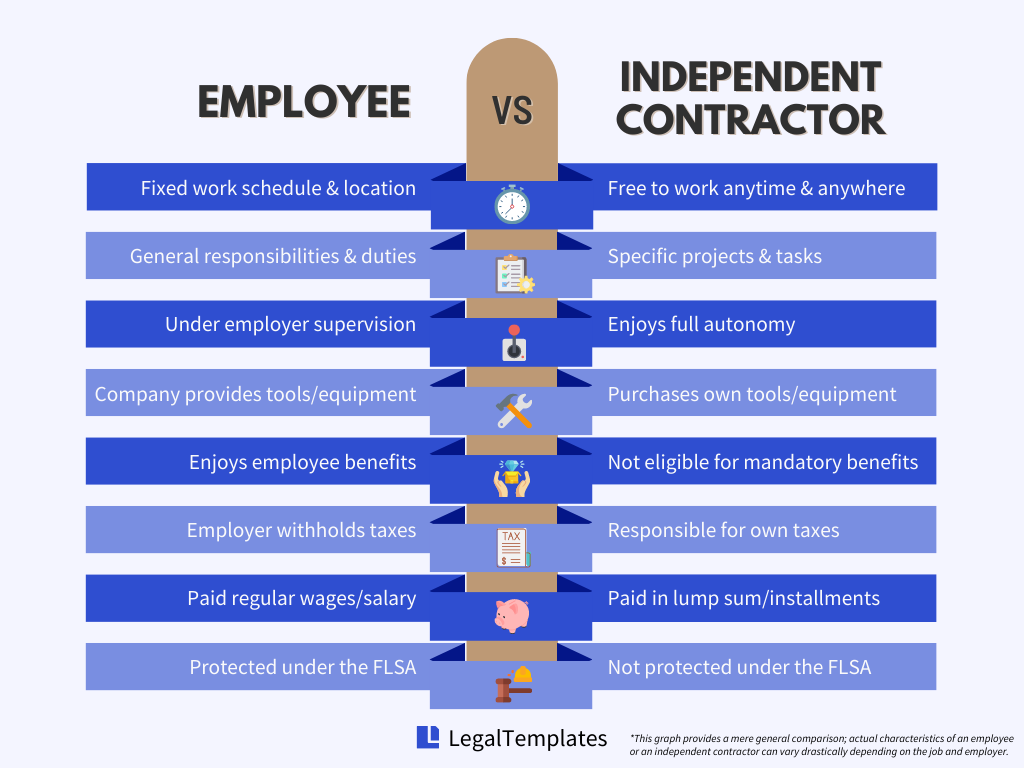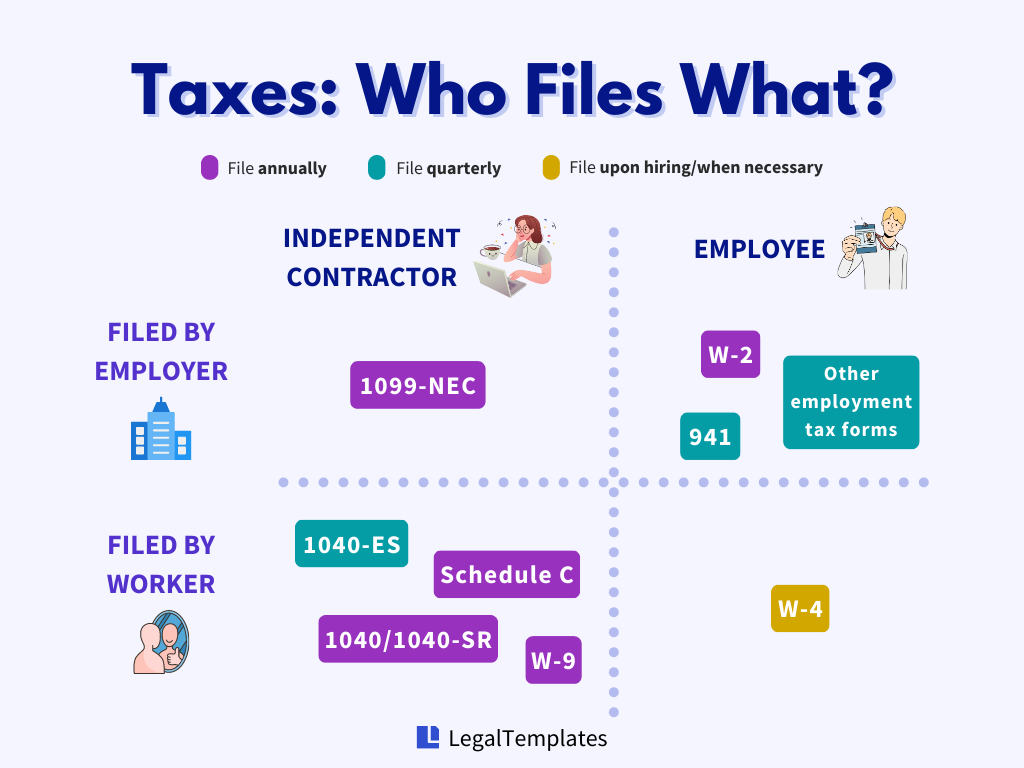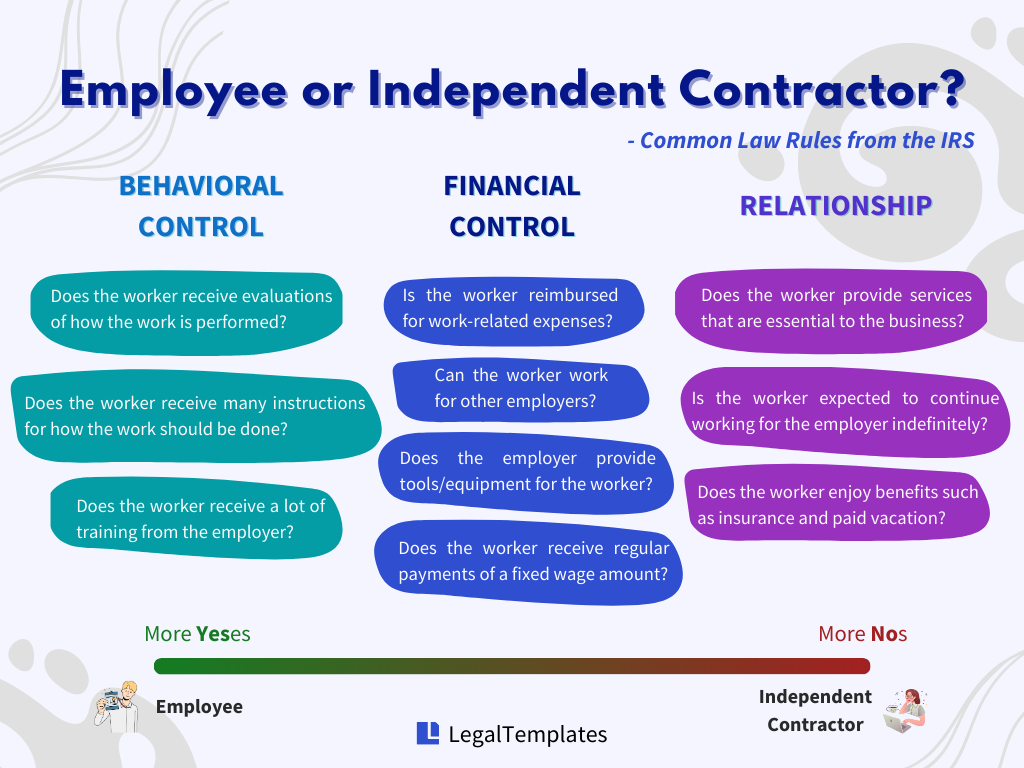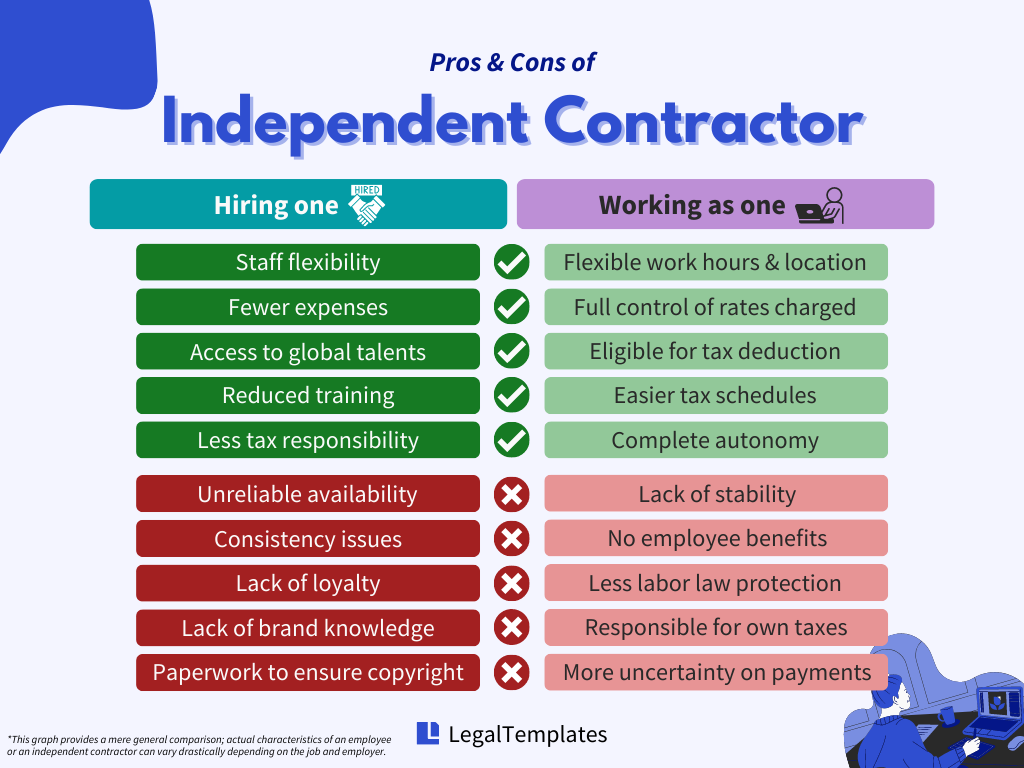
For business owners welcoming a new team member, the crucial step involves categorizing them as either an employee or an independent contractor. In this guide, we will guide you through the distinctions between an independent contractor and an employee, elucidating the significance of these classifications in the business realm.
Key Takeaways
- While an independent contractor enjoys a higher level of flexibility, an employee is eligible for the benefits required by employment law.
- Independent contractors and employees are taxed differently using different tax forms.
- Misclassification of workers may be regarded as fraud and can have great repercussions.
- Establish clear terms and conditions for both the employer and the employed with business contracts.
Employment Status
What is an employee?
An employee is an individual who “works under the supervision or control of an employer,” and the employer-employee relationship is usually established by an employment contract. Employees can be either part-time or full-time and are eligible for employee benefits in various degrees.
What is an independent contractor?
An independent contractor is an entity, either an individual (a freelancer) or a company, hired by an employer to complete specific projects and tasks defined in an independent contractor agreement. They are usually equipped with specialized skills or knowledge and enjoy the flexibility of potentially working for multiple companies.
Note
The IRS determines the worker’s status by examining how the parties work together instead of what’s written on the contract.
In other words, a worker’s status is not determined by the type of contract signed, even if the contract specifies whether the worker is an employee or an independent contractor.
Differences Between Employees and Contractors
Companies must identify which workers are employees and independent contractors for the IRS, primarily for tax reasons. Consider the following differences before working as—or hiring—independent contractors and employees.

Employment Laws
Employees: Employees are subject to a comprehensive set of federal and state employment laws, including minimum wage, overtime pay, workplace safety, and anti-discrimination laws. Employers must comply with regulations like the Fair Labor Standards Act (FLSA) and provide certain benefits such as health insurance and paid leave.
Independent Contractors: Independent contractors are not covered by most employment laws governing traditional employees. They are considered self-employed individuals responsible for their own compliance with tax and business regulations.
Hiring Practice
Employees: Employers have significant control over employees, determining work schedules, providing training, and directing the details of how the work is performed.
Independent Contractors: Independent contractors have more autonomy in their work. They are typically hired for a specific project or task, and the hiring party has less direct control over how the work is done.
Tax Documents
Employees: Employers must withhold income taxes, Social Security, and Medicare taxes from employees’ wages. Employees receive a Form W-2 at the end of the year summarizing their earnings and tax withholdings.
Independent Contractors: Independent contractors are responsible for handling their own taxes. They receive a Form 1099-NEC from clients who paid them $600 or more during the tax year, but they are responsible for reporting their income and paying self-employment taxes.
Important note
Form 1099-NEC is not required if your independent contractor is a C- or S-corporation.

Payer’s Tax Reporting Requirements
Employees: Employers must report wages and taxes withheld to the IRS and Social Security Administration regularly. This involves filing various tax forms, including Form 941, for quarterly reporting.
Independent Contractors: Payers are required to report payments of $600 or more to independent contractors by filing Form 1099-NEC. However, there is generally no need for quarterly reporting.
Reporting to Other Agencies
Employees: Employers are required to report new hires to state agencies for purposes such as child support enforcement.
Independent Contractors: There is typically no requirement for reporting the hiring of independent contractors to state agencies.
Value of Work or Contract
Employees: Employees are often compensated through regular salaries or hourly wages. Their compensation may include additional benefits such as health insurance, retirement plans, and paid time off.
Independent Contractors: Independent contractors are usually paid based on a contract or project basis. They may invoice for their services, and the payment structure is often tied to the completion of specific deliverables.
When Paid
Employees: Employees are typically paid on a regular schedule, such as bi-weekly or monthly.
Independent Contractors: Independent contractors are often paid upon completion of milestones or specific project phases. Payment terms are typically outlined in the contract between the parties.
It’s essential for businesses to correctly classify workers as employees or independent contractors, as misclassification can lead to legal and financial consequences. The classification depends on the nature of the working relationship and the degree of control the employer has over the worker. Consulting with legal and tax professionals is advisable to ensure compliance with relevant laws and regulations.
The IRS “Independent Contractor vs. Employee” Test
Before 2020, hiring entities used the IRS 20-point checklist to help determine whether a worker was an employee or an independent contractor; now, the IRS has applied a less complicated approach to an independent contractor test by distilling the 20-point checklist into three categories:
- Behavioral Control
- Financial Control
- Relationship

Behavioral Control
First, the IRS examines the degree of control an employer exerts over when, where, and how an employee works.
As previously mentioned, independent contractors generally enjoy a higher level of freedom in terms of working hours, work methods, and many other aspects of work. Suppose a worker receives relatively extensive evaluations of work performance, high degrees of instruction, and significant amounts of training. In that case, the IRS generally assumes a worker to be an employee rather than an independent contractor.
Who owns IP, the employer or the employee?
Generally speaking, employers own the intellectual property their employees create during the course of employment. Nevertheless, employers do not automatically own all intellectual property created during an employee’s employment.
If an employee creates an IP outside of their employment duties without using the employer’s resources, the employee may own it. Either way, it is recommended that both parties establish a clear consensus on IP ownership with a written contract.
Financial Control
Next, the IRS considers how much responsibility the employer holds concerning the financial aspects of the worker’s job.
For example, if an employer reimburses a worker for a particular tool the worker purchased to complete the delegated tasks, the worker is likely an employee. Although an increasing number of businesses are willing to reimburse freelancers for some expenses, most freelancers prefer to pick their own tools and obtain them with their own resources.
Relationship
Regardless of what’s in the employment contract, the IRS determines a worker’s status based on how the relationship is actually carried out. If the worker is hired for an indefinite period of time, provides services that are a key business activity, and enjoys benefits, the worker is likely an employee in the eye of the IRS.
Hiring an Independent Contractor: Pros & Cons
Not sure whether to hire an employee or a contractor? Consider the following pros and cons:
Pros
- Staff Flexibility: You don’t have to work with an independent contractor again if you don’t like their quality of work or work ethic.
- Fewer Expenses: You don’t need to provide a contractor with insurance, benefits, and other expensive forms of overhead.
- Access to International Talent Pools: Thanks to easy-to-use platforms such as Upwork and Fiverr, you have access to talented individuals worldwide.
- Reduced Training: You don’t typically need to provide training for contractors since they should be proficient in the skills you want.
- Less Tax Responsibility: You are not required to withhold federal income, social security, or Medicare taxes for independent contractors.
Cons
- Unreliable Availability: You may be unable to meet deadlines or complete work due to the unavailability of contractors.
- Unreliable Quality: You may experience issues of consistency in quality depending on the independent contractor you work with.
- Lack of Loyalty: You can’t stop independent contractors from working for other businesses (unless explicitly stated in a non-compete contract).
- Lack of Brand Knowledge: You may have to spend time explaining your brand to contractors you’re working with for the first time.
- Lack of Control: You cannot oversee tasks or dictate what tools are used.
- Copyright Issues: Some independent contractors may use their copyrighted work or assume they own what they create while working on your project. Ensure you have a copyright to work produced by independent contractors through an adequate contract—or you may not own the work you paid the contractor to create.
Working as an Independent Contractor: Pros & Cons
When deciding whether you prefer working as an employee or an independent contractor, consider the following:
Pros
- Flexibility: You can work anytime, anywhere, however you prefer.
- Fees: You can charge whatever rate you see fit for your services and accept as many contracts as you can complete.
- Tax Schedule: There is no employer to withhold taxes from your monthly earnings. Instead, you pay estimated taxes directly to the IRS four times a year.
- Tax Deductions: You can deduct work-related expenses from your taxable income (as independent contractors are usually not reimbursed).
- Autonomy: You don’t need to report to or justify your actions to anyone.
Cons
- Uncertainty: You may find the lack of guaranteed work and pay stressful.
- Lack of Benefits: You are not eligible for employer-provided health insurance, worker’s compensation, paid vacation time, and other benefits.
- Few Labor Law Protections: You may be eligible for certain protections, but none of the Fair Labor Standards Act laws apply to you, such as minimum wage and overtime pay.
- Risk of not Receiving Payment: You risk not getting paid on time—or at all—by clients.
- Taxes: You are responsible for filing your own taxes and any potential penalties for misfiling/misclassifications.

Consequences of Misclassification
The government wants its tax money, so it relies on each business to correctly classify every member of its workforce. Misclassified workers can wind up costing the government money—and you a fortune for the potential penalties.
The typical penalty is a fine, which can be steep depending on the severity of the offense. In most cases, the IRS will assess the situation and cut employers off when they think it was an honest mistake. Nevertheless, if the IRS deems the misclassification intentional, the misclassification is considered fraud, and the guilty party may face criminal prosecution and even jail time.
Make Proper Distinction
Understanding the difference between an independent contractor and an employee requires careful consideration, and both types of employment come with unique advantages and disadvantages.
Whatever relationship you choose for yourself or your workers, establishing terms and conditions in black and white is a crucial way to protect yourself and your business.
